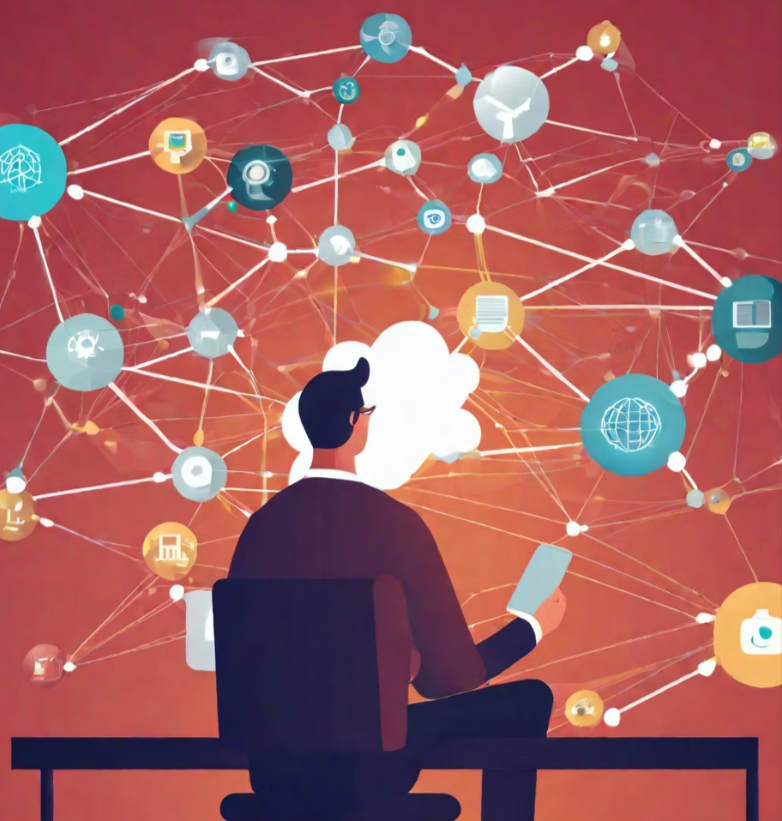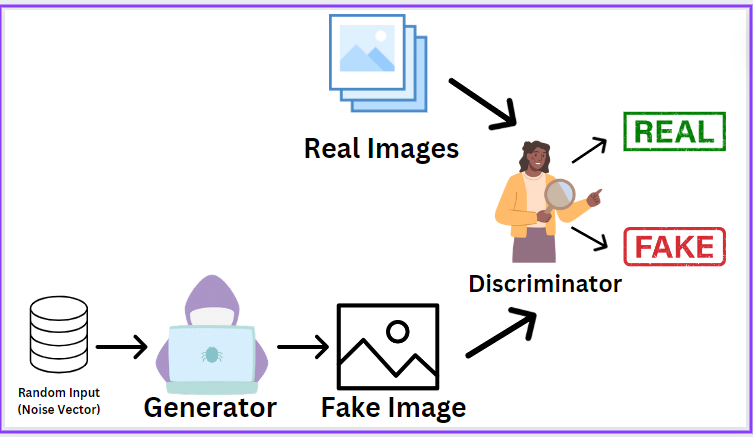Unveiling the Magic of GANs: A Deep Dive into Generative Adversarial Networks
 Trisha Banerjee
Trisha BanerjeeTable of contents

Introduction
Generative adversarial networks (GANs) have become one of the most popular and widely used deep learning techniques in recent years. These networks have redefined the boundaries of creativity and realism, enabling the generation of lifelike images, videos, music, and text. But what lies beneath the surface of these mesmerizing creations? Join us as we embark on a journey to uncover the inner workings of GANs, from the basics to the complexities, demystifying their magic and exploring their limitless potential.
What is a GAN?
A GAN consists of two neural networks - a generator and a discriminator - that compete against each other to become better over time. The generator tries to create synthetic data (e.g. images) that are as realistic as possible, while the discriminator tries to determine whether data instances are real or fake. Their adversarial "game" drives the generator to produce more and more realistic data until the discriminator can no longer distinguish fake data from real data.
Think of the generator as an art forger and the discriminator as an art expert. The forger creates fake paintings, and the expert's job is to spot the fakes. The forger gets better at imitating real paintings until the expert can't tell the difference.
The typical GAN workflow looks like this:
The generator takes in random noise as input and generates fake data (e.g. an image).
This fake data is fed into the discriminator along with real data from the training dataset.
The discriminator makes predictions - is each data instance real or fake? It is trained to get good at distinguishing real vs. fake.
The generator is updated based on the discriminator's predictions to get better at fooling the discriminator.
Repeat steps 1-4, training both networks alternatively, until the GAN converges and the generator creates realistic synthetic data.
Training Dynamics
The training of GANs is a dynamic process that involves alternating between two key steps: the discriminator loop and the generator loop. Let's break down these steps with a simple example.
Discriminator Loop:
Imagine you're a detective trying to distinguish between real and counterfeit currency. Here's how the discriminator loop works:
Initialize the Loop: You decide to inspect each banknote multiple times (let's say three times) to ensure you catch any counterfeit notes.
Inspect Fake Currency: You start by examining a stack of fake banknotes generated by a counterfeiter (the generator). Each time you examine a note, you jot down your assessment.
Inspect Real Currency: Next, you inspect a stack of genuine banknotes from a reputable bank (the dataset). Again, you carefully assess each note and record your findings.
Assign Labels: You label the fake banknotes as "counterfeit" (0) and the real banknotes as "genuine" (1).
Calculate Loss: Based on your assessments and labels, you calculate how well you performed at distinguishing between real and fake banknotes. If you made mistakes (e.g., misidentifying a genuine note as counterfeit), your loss would be higher.
Update Parameters: Using the calculated loss, you adjust your detective skills (parameters) to become better at identifying counterfeit currency. You do this by tweaking your inspection techniques, such as paying closer attention to certain features of the banknotes.
Repeat: You repeat this process multiple times (let's say three times) to refine your ability to detect counterfeit currency effectively.
Generator Loop:
Now, let's flip the scenario and imagine you're the counterfeiter trying to improve your fake currency to fool the detective:
Generate Fake Currency: You start by crafting a batch of counterfeit banknotes using your skills as a counterfeiter (the generator).
Assess the Quality: You evaluate how realistic your fake banknotes look compared to genuine ones.
Calculate Loss: Based on the detective's assessments (the discriminator's feedback), you calculate the quality of your counterfeits. If the detective is catching too many of your fakes, your loss would be higher.
Adjust Your Technique: Using the calculated loss, you refine your counterfeiting techniques (parameters) to produce more convincing fake banknotes. For example, you might improve the quality of the paper or enhance the accuracy of the printing.
Repeat: You repeat this process multiple times to hone your counterfeiting skills and create banknotes that are increasingly difficult for the detective to spot as fakes.

By alternating between the discriminator loop (detective) and the generator loop (counterfeiter), GANs learn to generate data that is increasingly realistic and indistinguishable from real examples. This dynamic interplay between the two networks drives the improvement of both, leading to remarkable results in artificial intelligence.
Mathematical Formulation
To grasp the essence of GANs, let's delve into the mathematical framework. With G as the generator and D as the discriminator, the generator transforms random noise z into synthetic samples x′=G(z). Meanwhile, the discriminator assesses the probability D(x) that a given sample x is real. The objective is to optimize both networks' parameters iteratively until the generator produces indistinguishable samples from real data.
GANs Equation
The crux of GANs lies in the interplay between the generator and discriminator, as encapsulated in the min-max game:
minGmaxD V(D,G)=Ex∼pdata(x)[logD(x)]+E z∼pz(z) [log(1−D(G(z)))]**
where pdata (x) represents the distribution of real data and pz (z) denotes the distribution of noise input.
Examples of GAN Applications
1. Image Generation:
StyleGAN: NVIDIA's StyleGAN has demonstrated remarkable capabilities in generating high-resolution, photorealistic images of human faces. These synthetic faces are indistinguishable from real ones, showcasing the potential of GANs in creating lifelike visuals.
BigGAN: Google's BigGAN model produces high-quality images across a wide range of classes, allowing users to generate diverse and realistic images of objects, animals, and scenes with unprecedented fidelity.
2. Data Augmentation:
AugGAN: AugGAN is a GAN-based approach for data augmentation in medical imaging. By synthesizing new images with realistic variations, AugGAN helps improve the generalization and robustness of deep learning models trained on limited medical datasets.
CycleGAN: CycleGAN enables unpaired image-to-image translation, allowing for domain adaptation without paired training data. This technique has been successfully applied to tasks such as style transfer, season transfer, and object transfiguration.
3. Anomaly Detection:
AnoGAN: AnoGAN combines GANs with a novel anomaly detection algorithm to identify outliers in unlabeled datasets. This approach has been employed for anomaly detection in medical images, industrial machinery, and network traffic.
DeepSVDD: DeepSVDD utilizes GANs to learn a representation of normal data, enabling the detection of anomalies as deviations from this learned normality. It has been applied to various domains, including cybersecurity and fraud detection.
4. Style Transfer and Translation:
Pix2Pix: Pix2Pix enables paired image-to-image translation, facilitating tasks such as converting sketches into photorealistic images, transforming day scenes into night scenes, and generating artistic renderings from photographs.
Text-to-Image Synthesis: Conditional GANs, such as StackGAN and AttnGAN, can generate images from textual descriptions. These models have been used to create scenes based on natural language prompts, opening avenues for interactive storytelling and content creation.
5. Future Applications:
AI-Generated Content Creation: GANs hold promise for automating content creation across various media, including video, music, and literature. Future advancements may lead to AI-driven content creation platforms that cater to individual preferences and artistic styles.
Virtual Reality and Simulation: GANs can be utilized to generate realistic virtual environments and characters for immersive experiences in virtual reality and gaming. As GANs improve in fidelity and efficiency, they may play a central role in the development of next-generation simulations and virtual worlds.
These examples illustrate the diverse range of applications for Generative Adversarial Networks, spanning from creative endeavors to practical solutions in data analysis, anomaly detection, and content generation. As GAN technology continues to evolve, we can expect to see even more innovative applications that push the boundaries of what is possible in artificial intelligence.
Think of GANs as magic paintbrushes that can create realistic images from scratch, transform images into different styles, and even turn text into pictures.
Conclusion
Generative Adversarial Networks represent a pinnacle of innovation in artificial intelligence, offering a canvas for limitless creativity and exploration. By unraveling the intricacies of GANs, we unlock a world of possibilities, from realistic image generation to text synthesis and beyond. As we delve deeper into the realms of GANs, let's embrace their transformative potential and embark on a journey of discovery in the ever-evolving landscape of artificial intelligence.
Subscribe to my newsletter
Read articles from Trisha Banerjee directly inside your inbox. Subscribe to the newsletter, and don't miss out.
Written by

Trisha Banerjee
Trisha Banerjee
I'm Trisha, an enthusiastic AI/ML student with an insatiable curiosity for deciphering the intricacies of data. Currently immersed in the exhilarating journey of evolving into a Data Scientist, I harmonize the artistry of machine learning with the precision of AI. In the expansive realm of data science, my passions revolve around unlocking the transformative potential inherent in AI and ML. I firmly believe in the profound power of data to illuminate insights and drive informed decision-making. Join me as I navigate the dynamic landscape of artificial intelligence, embracing the endless possibilities that arise when passion meets data-driven exploration.